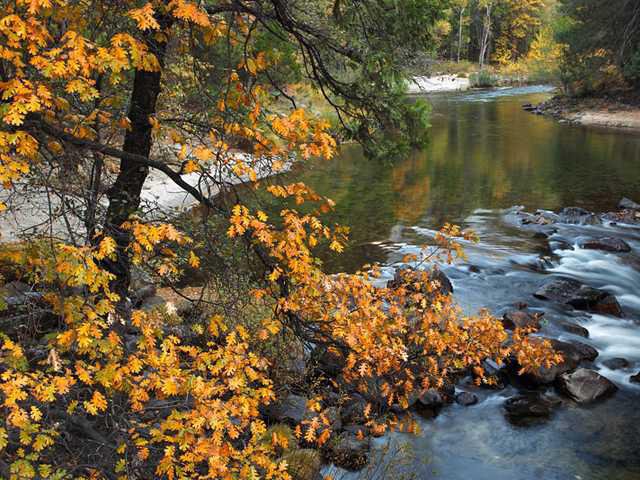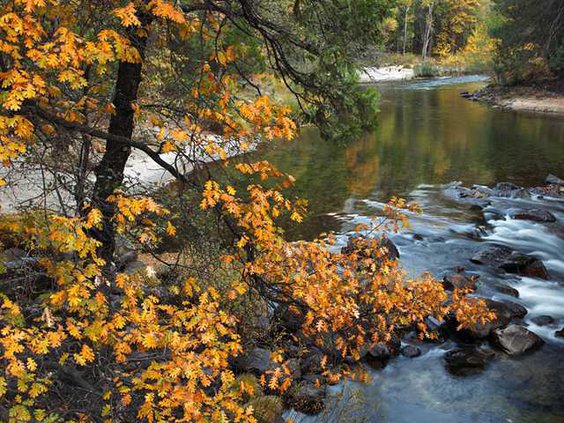If you ever wanted to visit Yosemite National Park without fighting tourist traffic every inch of the way, this month may be your best chance. In a kind of Perfect Storm combining the normal fall dip in traffic with public concerns about the Rim Fire, the park actually may have fewer visitors than just about any other time in recent memory.
Although this year there is some concern whether the park may be closed for awhile due to the federal government shutdown, the park generally stays open through October. The temperature dips but the experience remains one of California’s absolute best ways to immerse yourself in the beauty and natural surroundings of the High Sierra. Yes, it’s a little cool at night, but the lack of crowds and a few extra fall colors here and there certainly make up for it.
This year that’s compounded by the aftermath of the Rim Fire which was expected to be fully contained around the first of October. The fire is near Yosemite, but far enough away to not have an adverse effect on many of the usual fall activities at the park. The fire burned more than 77,000 acres at the northeast corner of the park but not the areas most frequented by tourists. For the first few days of October some fire activity was expected to continue although it was limited to smoldering and small outbreaks as crews moved close to full containment.
People who love Yosemite National Park breathed a collective sigh of relief when it was clear the fire was not going to destroy the many iconic natural symbols of the park. The waterfalls, sheer rock faces and trees all remain in most of the developed areas of the park. Altogether the park includes 1,200 square miles of natural wonders – grand meadows, giant sequoia trees and incredible wilderness, with postcard views in just about every direction.
All of that had been in jeopardy as the fire burned ever-so-close to the park, and all you have to do is look at the destruction in the fire area to see what might have been. Nearly 40 percent of the area burned by the Rim Fire is nothing but charred land, according to fire ecologists. It was, in fact, the third largest fire in California history, consuming 400 square miles. About 60 square miles of that is completely destroyed – everything in that area is dead.
If you’re going to Yosemite in October, you should know that all areas of the park usually remain open through October but there can be exceptions if there is an early snow, which would generally result in just a short-term closure in the affected areas. Along the Tioga Road, services aren’t available after September and overnight parking isn’t permitted after October 14. Yosemite Valley and Wawona are accessible by car all year, but tire chains may be required depending on conditions.
The weather this time of year in Yosemite is quite variable and can range from hot to cold, and from dry to rainy and snowy. If you’re counting on seeing huge rushing waterfalls, this isn’t the time of year to see those – the water levels in October are usually quite low. Some of the famous Yosemite falls like Vernal, Nevada and Bridal Veil are just trickles of water by the fall season. While it may seem logical that October would be the ideal time to see fall colors in Yosemite, the colors are not as pronounced as in many other mountain areas because most of the trees are evergreen. However, big-leaf maples, Pacific dogwoods and other deciduous trees do show quite a bit of color, usually through mid-October.
Many of the usual activities are still available in the fall such as hiking, picknicking, biking, rock climbing, birdwatching and just touring the park by car. Most lodgings and restaurants remain open through October, and of course camping areas are open as well. If you’re headed to Yosemite from Southern California, take I-5 north (or I-405 north to I-5) to Highway 99 north to Highway 41 north (Fresno) into the park. If coming from San Francisco, take I-580 east to I-205 east to Highway 120 east (Manteca) or Highway 140 east (Merced) into the park.
For more information on Yosemite National Park, visit www.nps.gov/yose/index.htm. For the latest information on the Rim Fire, go to inciweb.nwcg.gov/incident/3660.
TIME TO FALL IN LOVE
Great time to visit Yosemite if feds will fund it





